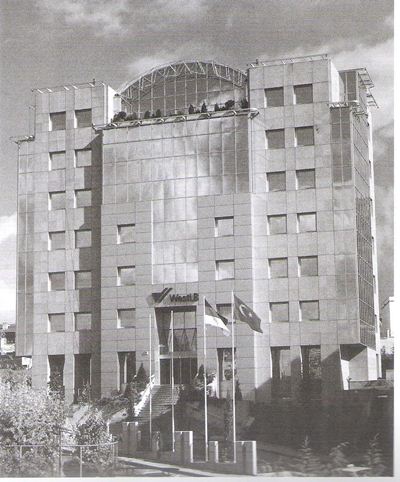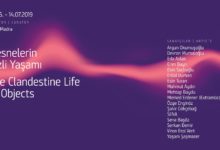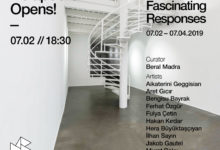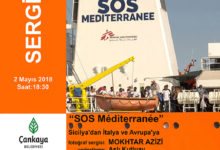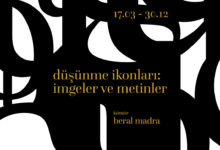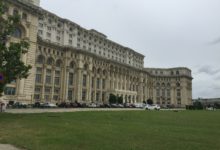WESTDEUTSCHE LANDESBANK CONTEMPORARY ART PROJECTS
Westdeutsche Landesbank, İstanbul Director Dr. Peter Weingartz’ın projenin açılış metni:
Rune Mield’in yapıtlarıyla Westdeutsche Landesbank, Istanbul’daki binasının içinde Türk ve Alman sanatçıların sergilerini açma geleneğini başlatıyor.
WestLB’nin Akatlar’daki yeni binası her yıl Almanya’dan ve Türkiye’den birer sanatçıyı konuk edecek. Her sanatçı bir dizi seçkin yapıtla temsil edilecek. Bu bağlamda WestLB, Istanbul sanat ortamına uzun süreli bir sanat desteği vermeyi üstlenirken, sergilerimiz Beral Madra tarafından düzenlenecek.
Rune Mield’in resimleri, bilimsel ve teknolojik gelişmenin ve siyaset, ekonomi ve toplumsal yaşamı aşan bir matematik dünyasının karşılığı olan sayılarda ve işaretlerde – matematik ve geometride- temellenerek, Islam felsefesi ve Islam sanatı düzenini de yansıtıyor. Rune Mields’in sergisi, yol boyunca iki kültürden başka sanatçıların da katılacağı yolculuğumuzda ilk kilometre taşı olacak.
RUNE MIELDS
“Eternal and Solitary”
Westdeutsche Landesbank Contemporary Art Project
October/Ekim 1999- March/Mart 2000
With the exhibition of Rune Mields, the reknown artists from Nordrheinwestfalen, WestLB initiates a new project as a longterm contribution to Istanbul art scene. The new building in Akatlar will host one artist from Germany and one from Turkey every year who would be represented with a selected cycle of works that will be displayed in the spaces reserved for this project.
The concept and aim of this project is two fold.
When founding a patronage of art, one must consider the fact that since the 80’s new art moved to more enviromental directions where the viewer becomes a part of the work rather than an observer. It is not hard to say why so many artists are working on project basis and produce installations rather than ready paintings and sculptures at our times. Since the beginning of 80’s there has been a radical shift in the formal modernist relationship between the artist and the viewer. There is a certain complexity within the process that goes on between the viewer and the viewed due to the richness and speed of creative images spread with the electronic and computing technology. The art has been searching new modes and processes to contest this fact.
On the other hand the accumulated histories / sub-histories and narratives of the world forces the artist to work with different materials and techniques in order to transform life into art and art into life. The works we see in exhibitions all over the world respond in very different ways and techniques to the given space and time and in turn require the direct physical involvement of the viewer.
The art project to be established for the building of Westdeusche Landesbank in Istanbul, therefore, gives the company an opportunity to present this latest movement in art with prominent artist of Nordrheinwestfalen and Turkey, whose work, by interpreting the space, time and concept of the building, will challenge the perception of the company members and the visitors.
Catalogue Text
It is clearly acclaimed that Modern and Post-modern art owe their worldwide impact to the support by collectioners and multinational companies. There have been many ways of maintaining the continuity of this phenomene. Some companies collected paintings and scupltures, the others sponsored projects and exhibitions or comissioned art works. Most of the time these collections were donated to museums or created the heart of a new museum.
However, it is hard to say that this is the same for Turkey. Up until the beginning of the 80’s art and culture in Turkey was mainly determined by state policies and funds. Since almost two decades contemporary art gained its independency due to the interests of private enterprise, galleries and foundations. However, mostly the established artists can enlarge their horizons within this developing art scene; therefore contemporary art scene in Turkey requires visionary entrepreneurial collectors and sponsors in order to promote young generations.
The art production today is too complicated to give opportunity to the collector to say “I buy, because I love it!”. This is more so in Turkey. The art patronage in Turkey will bear its fruits only when constancy and determination are the key concepts of the purpose.
When founding a patronage of art, one must consider the fact that since the 80’s new art moved to a more space specific direction, where the viewer becomes a part of the work rather than an observer. It is not hard to say, why so many artists are working on project basis and produce installations beside paintings and sculptures at our times. Since the beginning of 80’s there has been a radical shift in the formal modernist relationship between the artist and the viewer. There is a certain complexity within the process that goes on between the viewer and the viewed after the emergence of creative images spread with the electronic and computing technology and after the speed and multiplicity of these images. In one way, the artists, with their traditional forms and techniques, are searching new modes and processes to contest this fact; in another however, as the human spirit still seeks for an art which should be perceived in serene and meditatif terms, they are pursuing genealogical investigations towards formal and conceptual minimalism.
Once again, the uncontrollable accumulation of world events and simulated narratives through information flow forces the artist to work with different materials and techniques, in order to transform life into art and art into life. The works we see in exhibitions all over the world respond to these predicaments in very different ways and techniques, specially reacting to the given space and time, most of the time by incorporating the direct environmental facts and in turn require the direct physical involvement of the viewer. The art project to be established for the building of Westdeutsche Landesbank in Istanbul, therefore, gives the company an opportunity to present this latest movement in art with prominent artist of Düsseldorf and Istanbul, whose work, by engaging themselves to the space, time and concept of the building, will challenge the perception of the company members and the visitors. The first activity of this promising venture will be realized with the exhibition of Rune Mields entitled “Eternal and Solitary”.
Born in Münster, 1935 Rune Mields is currently living and working in Köln. Since 1986 she has extensively presented her work in private and official galleries and participated in group shows in Germany, West and East Europe, USA. With her series mainly based on her reflections on the meaning of the numbers and signs in different cultures throughout the centuries, Rune Mields undertakes a resolute position within the paradoxal context, of pursuing or not pursuing the turbulent course of events and introduces a composing and cogitative experience to the perception of today’s viewer. By surveying the invisible intricacies and concepts between the numbers and signs and depicting her discoveries in series, she consequently creates an alien and solitary enviroment for the viewer of today. For the viewer continously being assaulted by the pluralistic figurative visual electronic media artillery, her paintings create a sense of meditative distance with their abstract patterning of the numbers as well as a delightfull engagement with their vertigo-causing transcendency. Rune Mield’s art offers the spectator a sense of spatial and temporal displacement and a desire to contemplate the infinite boundaries of the eternity and solitariness, which are inherent in the numbers. This, more than other aspects of her work, creates a very discrete implication that somewhere along the border of today’s heterogeneous and disrupted art, there is still a place for mental and visual liberation and a unity of thought and sensuality. There is a possibility of multiple readings in these enigmatic compositions.
One can read, that the esthetic value of a work developes from the logic of the concepts, in this case from the logic of numbers and signs.
One can also read, that an artwork cannot be completed only with individuality, style and form, but should also follow a path into the structure of things and find the prime-image, in this case an image of divine order reflected in the numbers and signs.
One can also read, that the past cultures conceal many archetypes which can still be articulated within the post-modernist practice and have an adequate function.
The painting cycles present an analytical approach to the twofold meaning of numbers and signs.
Firstly, the artists takes her inspirations from the past cultures, unequivocally at a level, where science converges with the mythical and magical thinking. No doubt, in spite of all scientific and technological progress this convergence is still prevailing in the mind of post-modern man. Consequently the artist employs a kind of promise of psychological transendence, in order to fulfill the desire of this spectator.
Secondly, today, numbers and signs stand for the mathematical world order which is dominating the politics, the economy and the city-scape . They also represent an immediate authority, power and control as structures and sytems based on numbers and signs. Hence they can convey chaos or harmony. Not to forget the incidental combinations of numbers and signs that can cause death or life. Consequently the artists invites the spectator to reflect on the systems dominating our lives. Yet, the invitation is accomplished in a sublime mode; she tempts the viewer to escalate between empirical procedures and deductive reasoning.
Rune Mields painting should have been exhibited in Turkey long before; for the reason that the Islamic philosophy as well as the canon of Islamic art is somehow implicit in her art. The history of modern art is full with examples, wherein Islamic philosophy and art has been integrated and recycled in different forms. Rune Mields’ ingenious choice reminds us that when Muslim culture travelled its spectacular passage from East to West during the 10th and 11th centuries, it transmitted among other sciences, the Hindu and Greek knowledge of numbers (or mathematics) to Europe. Moreover, she reminds us that, when we assemble the meaning of numbers in different cultures and religions, we achieve a vast spectacle of philosophy, logic, critical study and theory about what has happened and happening on this planet: Zero is the unlimited, the absolute, the eternal; One is the beginning, the sum of all possibilities; Two is diversity, conflict and otherness; Three is multiplicty, growth, forward movement; Four is the static as opposed to the circular and the dynamic; Five is the human microcosm; Six as equilibrum and harmony; Seven as macrocosm; Eight as regeneration, resurrection and felicity; Nine as the beginning and the end, the whole and the fulfilment.
Her statement in her catalogue printed 1996 for her exhibition in Marburger Universitaetsmuseum für Kunst und Kulturgeschichte, is not only revealing the affinity of her philosophy to the Islamic art, which is based on mathematics and geometry and which transformed signs into intricate and infinite patterns, but also imparts a more quintessential involvement with this traditional convergence of mathematics and esthetics, of rationality and sensuality, of concept and decoration.
“The main part of my work consists of exploring and questioning the systems and structures. Accurately defined, they are logical systems that yield or can yiled visual structures. Rational, old or new and already existing systems that are not developed by me, but picked from the reality, are most of the time systems that have not been observed in their visual character. Some of these systems are not at all recognized as rational, but evaluated as magic and mythic. Still their roots are to be acknowledged in the ratio and desire of man.”
Beral Madra/August 1999
Katalog Metni
Sanata destek vermeyi üstlenirken, 80’li yıllardan bu yana, izleyicisinin gözlemci olmaktan çok katılımcı durumuna geçtiği, daha çevresel yönelimli yeni bir sanatın varlığını kabul etmek gerekir. Birçok sanatçının proje temelinde çalıştığını, hazır resim ve heykel yanında yerleştirmeler yaptığını ve 80’lerin başından bu yana sanatçı ve izleyici arasındaki biçimci modernist ilişkide köktenci bir değişim olduğunu söyleyebiliriz.
Elektronik ve bilgisayar teknikleriyle yaygınlaşan yaratıcılık taşıyan imgelerin hızı ve zenginliği dolayısıyla, bakan ve bakılan arasındaki süreçte belirgin bir karmaşıklık söz konusudur.
Sanatçılar, bir bakıma geleneksel biçimler ve tekniklerle bu gerçekle yarışmak için yeni biçimler ve işlemler arıyor, bir bakıma da, insan ruhu hala dingin ve derin düşünceci koşullar içeren bir sanata özlem duyduğu için, biçimsel ve kavramsal bir minimalizme doğru giden soykütüğü araştırmalarına giriyorlar.
Öte yandan, bilgi selleriyle yayılan dünya olaylarının ve taklitçi anlatıların denetlenemeyen birikimi karşısında, sanatçılar yaşamı sanata, sanatı yaşama aktarmak adına, değişik teknikler ve malzemelerle çalışmaya zorlanıyorlar. Dünyanın heryerinde sergilerde görülen, bu önkoşullara değişik yollar ve tekniklerle yanıt veren, özellikle mekana ve zamana tepki gösteren yapıtlar, çoğu kez doğrudan doğruya çevresel gerçekleri kapsıyor ve izleyicinin de katılımını gerektiriyor.
Istanbul’da Westdeutsche Landesbank’da gerçekleştirilen ve bu özellikleri taşımayı amaçlayan bu sergi dizileri, bu kuruma sanattaki en son gelişmeleri, binanın mekan ve zaman boyutlarını içine alan işler üretecek olan Düsseldorf ve Istanbul’dan ünlü sanatçılarla sunma olanağı verirken, kurum çalışanlarının ve konukların ilgisini çekmeyi amaçlıyor.
Bu önemli sonuçlar vaad eden girişimin ilk sergisi Rune Mields’in “Sonsuz ve Yalnız” başlıklı sergisiyle başlıyor.
1935’de Münster’de doğan Rune Mields, şimdilerde Köln’de yaşamakta ve çalışmaktadır. 1967’den bu yana yapıtlarını Almanya, Batı ve Doğu Avrupa ve ABD’de özel ve kurumsal galerilerde sergilemiş ve çok sayıda grup sergisine katılmıştır.
Rune Mields, sayıların ve işaretlerin yüzyıllar boyunca değişik kültürlerdeki anlamları üstüne yaptığı araştırmalarda temellenen yapıt dizileriyle olayların fırtınalı akışının izlendiği ya da izlenemediği çelişkili bir ortam içinde kararlı bir tavır alıyor ve günümüz izleyicisinin algısına birleştirici ve tasarlayıcı deneyimler sunuyor.
Mields, sayılar ve işaretler arasındaki görünmez ilişkileri araştırarak ve buluşlarını resim ve desen dizilerine dönüştürerek, günümüz izleyicisi için yabancı ve yalnız bir ortam kurmaktadır. Çoğulcu, figüratif görsel elektronik medya silahlarının sürekli saldırısına uğrayan izleyici için bu resimlerdeki sayıların oluşturduğu soyut biçimler hem derin düşünce duygusu uyandıran bir uzaklık, hem de baş döndüren aşkınlıklarıyla zevkli bir buluşma yaratırlar.
Rune Mields’in sanatı, izleyiciye zamansal ve mekansal bir yer-değiştirme duygusu ve sayıların içeriğindeki sonsuzluk ve yanlızlıkla ilgili sınırsızlığı anlama isteği verir. Bu, günümüz heterojen ve kopuşlu sanatının sınırlarındaki bir yerlerde, zihinsel ve görsel bir özgürlüğün ve düşünce-duygu birlikteliğinin varolduğuna ilişkin çok tedbirli bir değinmedir.
Bu bilmece gibi kompozisyonlarda çoğul okuma olanakları vardır. Kavramın mantığından, yani bu durumda sayıların ve işaretlerin mantığından türeyen bir estetik değer okunabilir.
Bir yapıtın yalnız bireysellik, uslup ve biçimle doyuma ermediği, yaratılan imgenin yapısına doğru bir izin sürülmesi ve ilk imgenin bulunması gerektiği, okunabilir ki, buradaki imge göksel bir düzene aittir. Geçmiş kültürlerin hala birçok ilkörnek gizlediği ve bu ilkörneklerin post-modernist uygulamalar içinde kullanılabileceği ve bunun için upuygun bir işlev taşıdığı, okunabilir. Resim dizileri, sayıların ve işaretlerin çift anlamlarına doğru çözümleyici bir yaklaşımı sunarlar.
Sanatçının esin kaynağı geçmiş kültürlerdir, ancak bu kaynak, kuşkusuz bilimin mitsel ve büyüsel düşünce ile kesiştiği düzlemdedir. Yine kuşkusuz, bütün bilimsel ve teknolojik ilerlemeye karşın, bu kesişme, post-modern insanın bilincinde durmaktadır.
Dolayısıyla, sanatçı, izleyicinin bu gizli isteğini karşılamak üzere, bir çeşit psikolojik aşkınlık sözü vermeyi üstlenir. Öte yandan gübnümüzde sayılar ve işaretler siyaset, ekonomi ve kent ortamı içinde geçerli olan matematik bir düzenin yerini tutarlar. Sayılar ve işaretlerde temellenen sistemler ve altyapılarla kurulmuş bir yetke, güç ve denetim söz konusudur. Bu bağlamda karmaşa ya da uyum iletebilirler. Sayıların ve işaretlerin erastlantısal bireşimleri sonucunda ölüm ya da yaşam gerçekleştiğini unutmayalım.
Sonuçta, sanatçı izleyiciyi yaşamımızı denetleyen sistemler üstünde düşünmeye çağırı. Ancak bu çağrı “yüceltilmiş” bir düzlemde gerçekleşir; sanatçı izleyiciyi empirik süreçlerle tümdengelici ussallık arasında iniş çıkışa iter.
Rune Mield’in resimleri Türkiye’de çok önce sergilenmeliydi; sanatında islam felsefesi ve Islam sanatı kurallarının bir biçimde yer alması, bunun başlıca nedenidir. Modern ve Post-modern Sanat Islam felsefesinin ve sanatının beimsendiği ve yeniden üretildiği örneklerle doludur.
Rune Mield’in bu hünerli seçimi bize, Islam kültürü 10. ve 11. Yüzyıllarda Doğudan Batı’ya o görkemli yolculuğunu yaparken, diğer bütün bilimlerle birlikte, Hint ve Yunan kökenli sayılar bilgisini (ya da matematiği) Avrupa’ya ilettiğini anımsatıyor. Dahası, sanatçı bize, eğer bu sayıların bütün kültürler ve dinlerdeki anlamlarını biraraya getirirsek, bu gezegende olanlar ve olmakta olanlar üstüne uçsuz bucaksız bir felsefe, mantık, eleştiri ve kuram şöleni elde edeceğimizi de anımsatıyor: Sıfır sınırsızdır, saltıktır, sonsuzdur; Bir başlangıçtır, bütün olanakların toplamıdır; Iki farklılıktır, çelişkidir, ötekiliktir; Üç çoğulluktur, büyümedir, ileriye gitmedir; Dört, çembere ve dinamik olana karşın statik olandır; Beş insan küçükevrenidir; Altı denge ve uyumdur; Yedi büyükevrendir; Sekiz yeniden doğuş ve mutluluktur; Dokuz başlangıç ve sondur ve doyumdur.
1996’da Marburg Üniversitesi Sanat ve Kültür Müzesi’ndeki sergisi dolayısıyla basılan kataloğundaki sözleri, sanatçının yalnız matematik ve geometride temellenen ve işaretleri karmaşık ve sonsuz motiflere dönüştüren Islam felsefesi ve sanatına yakın ilgisini açıklamakla kalmıyor, aynı zamanda, bu matematik ve estetik, ussallık ve duyumsallık, kavram ve sğsleme arasındaki bu geleneksel bireşmeye ilişkin daha köklü bağlılıkları bildiriyor.
“ Yapıtımın ana bölümü, sitemlerin ve yapıların araştırılması ve sorgulanmasından oluşur. Tam olarak tanımlanırsa, bunlar görsel yapılar veren ya da verebilen ussal sistemlerdir. Ussal, eski ya da yeni ve halihazırda var olan sistemler, ki bunlar benim tarafımdan geliştirilmedi, ama gerçeğin içinden seçildi. Bunlarıhn çoğu, görsel neitelikleri açısından gözlemlenmemiştir. Bu sistemlerin bazıları ussal olarak kabul edilmez, büyüsel ve mitolojik olarak kabul edilir. Ne olursa olsun bunların köklerinin, insan usunun ve isteğinin içinde olduğu bilinmektedir.”
Beral Madra Ağustos 1999












